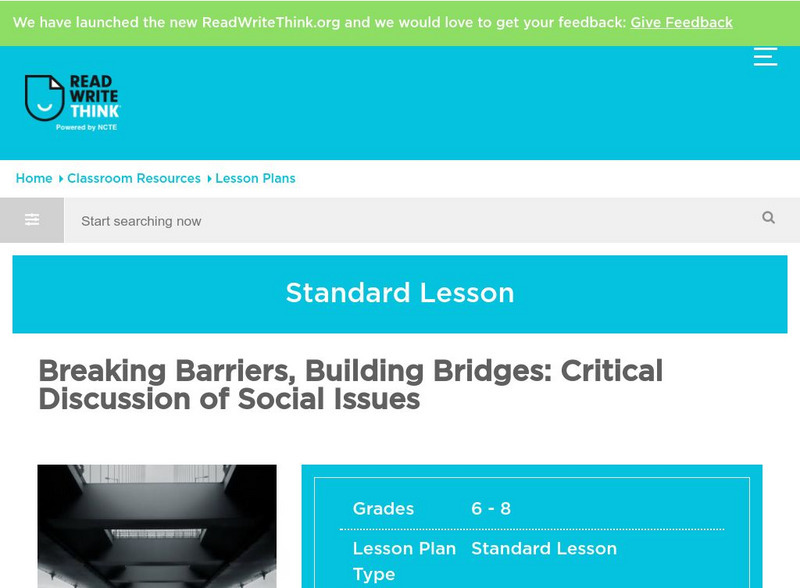Hi, what do you want to do?
National Woman's History Museum
Getting with the Program
A seven-step lesson introduces the emergence of computer sciences and the contributions women made to the profession after World War II. Several science experiments offer pupils a hands-on learning experience that showcases parabolas,...
Curated OER
Through Their Eyes: Video Taping Oral History
Young scholars identify the stereotypes they are faced with on a daily basis. In groups, they use this information to identify the ways stereotypes are portrayed in movies and television. They use a video camera to record oral...
Crafting Freedom
F.E.W. Harper: Uplifted from the Shadows
What is stereotyping, and how do we handle stereotyping in our daily interactions? Your young historians will not only have the opportunity to learn about the first African American woman to publish a short story–Frances Ellen...
Curated OER
Infusing Equity by Gender into the Classroom: Those Ancient Greeks
High schoolers compare the treatment of men and women in Athens and Sparta. In this gender roles lesson, students research daily life in the Greek cities and create charts that compare the lives of women and men in both of the cities.
Crafting Freedom
F.E.W. Harper: Uplifted from the Shadows
Young historians discover the life of an incredible African American woman who, as an anti-slavery lecturer prior to the Civil War, defied stereotypes of what women could accomplish. Pupils explore the concept of stereotyping, read...
Curated OER
Infusing Equity Vs Gender into the Classroom
Students explore the effect of gender bias in the classroom. In this statistics lesson, students discuss the effects of stereotyping, discrimination, and gender bias in the classroom. They collect data on different work places dealing...
Curated OER
When Johnny Came Marching Home
Learners examine the concept of gender bias. For this discrimination lesson, students research 1940's and 1950's America and determine how historical events shaped the changing role of women in the country.
Curated OER
Casting Doubt: "Color-blind" and Nontraditional Casting Decisions
In his article about color-blind casting entitled, "Willy Loman Is Lost, Still Looking for Stimulus Plan and Some Dignity," Charles Isherwood quotes August Wilson as saying, "To mount an all-black production of a 'Death of a...
Curated OER
WHEN JOHNNY CAME MARCHING HOME
Students examine the roles of men and women throughout history.
Curated OER
OBSERVING THE ROLES OF MALES AND FEMALES IN THE NURTURING OF THE YOUNG THROUGHOUT THE ANIMAL KINGDOM
Students watch animal videos to identify and compare the male/female roles of different species of animals. They draw conclusions and compare those roles to those of humans. They discuss how the human male/female roles have changed...
Curated OER
THOSE ANCIENT GREEKS
High schoolers research Athens and Sparta and based on their research they are to make a visual aid showing their findings.
Curated OER
Gender Equity in the Classroom
Students review employment statistics and wages over the past 20 years. They examine the Federal Work Force Laws. They apply formulas to find the rate of change in the minimum wage.
Curated OER
Japanese Culture
Ninth graders examine the differences in the way genders have been treated in the same society over the course of a nation's history. In this World History lesson plan, 9th graders study the factors that have caused changes in...
Curated OER
Issues in Public Education During the Kentucky Civil Rights Era
Young scholars conduct oral history interviews and research historical and contemporary media articles about multiculturalism and diversity.
Curated OER
Let's Get Cooking
First graders create food from their cultures and present food and its history with the rest of class. They read "Everybody Cooks Rice" and everyone tastes the meals brought into class. They write a paragraph describing the reason for...
Curated OER
My Family Tradition
Learners examine different family traditions to further explain social patterns. They complete a graphic organizer using educational software.
Curated OER
You're a Grand Ol' Flag
Learners explore American flag and its symbols, and create an original flag that represents what they see in their own lives.
Teaching Tolerance
The Power of Words: Ethnic Stereotypes
Pupils study stereotypes that are associated with different ethniciites or regional groups. They examine how occupations can be hypothetically related to ethnic sounding names.
Curated OER
“And Still I Rise” Proud Black Women
Learners examine the experiences of African American women. In this poetry lesson, students use their literary analysis skills to compare the poetry of Maya Angelou to rap music performed by Queen Latifah and Lauryn Hill.
Curated OER
United States All the Way
Students create patriotic books about the United States and some of its special symbols.
Curated OER
Soap Opera Unit of Work: KS4
Pupils view an episode of "Eastenders." They look at how the programme is structured in terms of individual scenes. Students view the opening of the soap and the significane of the theme music. They look at the characters and trace the...
ReadWriteThink
Read Write Think: Breaking Barriers: Critical Discussion of Social Issues
Through a series of picture book read-alouds and journal entries, students engage in critical discussion of complex issues of race, class, and gender.




























